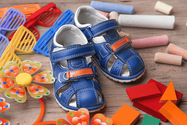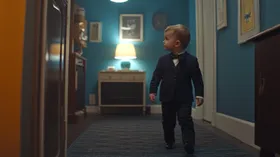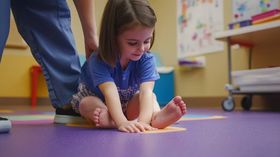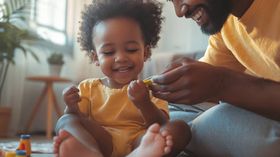6 Essential Tips For Buying Your Baby's First Shoes
From first steps to first adventures: Discover the perfect pair of shoes for your baby's growing feet
Published October 17, 2024
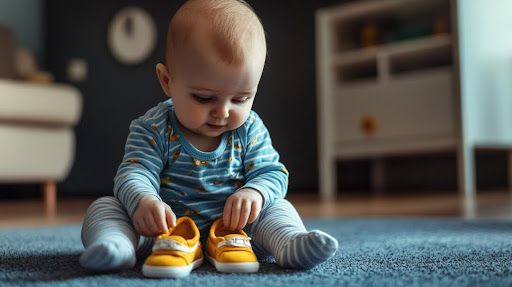
Your baby's first steps are a monumental occasion, beginning a lifetime of exploration. But before you rush out to buy the cutest miniature sneakers you can find, let's talk about what really matters when it comes to your baby's first shoes.
It's not just about finding the cutest pair—though that's certainly a bonus! The right first shoes can make a big difference in your child's comfort and development. Here's what you need to know to step in the right direction.
» Give your baby's feet the support they need with high-quality first shoes
When Is the Right Time?
Every child develops at their own pace, but generally, babies are ready for their first pair of shoes when taking their first independent steps. This usually happens between 9 and 18 months old.
Here are some signs that your little explorer might be ready for their first pair:
- Your baby is taking their first independent steps—they're confidently cruising around the furniture or taking their first solo steps.
- They're showing improved balance and coordination—this means walking more steadily and stumbling less.
- You notice changes in your baby's foot shape. As your baby grows, you might see the beginnings of arch development.
» Discover how to pick shoes for different stages of your kid's development
6 Top Tips When Buying Your Babies First Shoes
1. Prioritize Flexibility and Breathability
Your baby's first shoes should be as flexible as a yoga instructor. Look for shoes that you can easily bend and twist. This allows for natural foot movement and helps strengthen those tiny muscles and bones.
Breathability is equally essential. Nobody likes sweaty feet, especially babies! Opt for shoes made from breathable materials like leather. This helps prevent overheating and keeps those little tootsies comfortable. Breathable shoes are also good for seasonal transitions, keeping feet cool during warmer months and reducing perspiration.
» Explore kids' shoes for orthotics and support your little one's foot health
2. Measure Both Feet Regularly
Babies' feet grow faster than weeds, so measuring both feet regularly is crucial. Don't be surprised if one foot is slightly bigger than the other—it's perfectly normal!
When measuring, ensure your baby is standing (if possible) as feet spread out when bearing weight. There should be about a thumb's width of space between the end of the longest toe and the front of the shoe. Not too tight, not too loose—just right!
Remember to check the fit every few weeks. Babies can outgrow shoes in as little as two months, so what fits perfectly today might be too snug before you know it.
» Browse the best shoes for your baby's development
3. Choose Non-Slip Soles for Safety
As your baby navigates different surfaces, from slippery kitchen floors to bumpy sidewalks, non-slip soles are your secret against tumbles and falls. Look for shoes with textured soles that provide good traction.
However, be careful not to go overboard with thick, heavy soles. While they might seem more protective, they can actually make it harder for your baby to balance and develop proper walking skills. The goal is to find a balance between grip and flexibility.
» Explore the best shoe fabrics for children's feet
4. Go for Adjustable Fastenings
Velcro, elastic, or adjustable straps aren't just convenient for quick changes; they also let you adjust the fit as your baby's feet grow. It's like having a built-in growth spurt accommodation!
Adjustable fastenings also make it easier to put on and take off the shoes, which is a blessing when you're dealing with a wiggly baby. Plus, as your child grows and becomes more independent, they'll be able to put on and take off their shoes by themselves—a big step towards self-sufficiency!
» Support their first steps with shoes designed for babies learning to walk
5. Consider the Activity and Environment
Just like adults, babies need different shoes for different occasions. Think about where and how your baby will be wearing the shoes:
- For indoor play: Opt for lightweight, super flexible shoes that mimic the barefoot experience. Soft-soled shoes are perfect for this.
- For outdoor adventures: Choose sturdier shoes with good traction to protect those tiny feet from rough surfaces and provide stability. Look for shoes with more structure and support but still maintaining flexibility.
- For water play: Consider water-friendly shoes with quick-drying materials and a good grip for slippery surfaces.
- For special occasions: Yes, those tiny dress shoes are adorable, but make sure they're still comfortable and allow for natural movement. Avoid shoes with heels, no matter how small!
» Explore the best durable kids' sneakers for active playtimes
6. Pay Attention to the Upper Material
The material of the shoe's upper part is just as important as the sole. Look for soft, supple materials that won't rub or chafe your baby's delicate skin. Natural materials like leather or canvas are often good choices as they're durable and allow the foot to breathe.
Avoid synthetic materials that don't allow for air circulation, as these can cause your baby's feet to sweat excessively. Also, be wary of shoes with a lot of decorative elements like sequins or hard plastic pieces—while they might look cute, they can be uncomfortable and potentially hazardous if they come loose.
» Read our parents' guide to helping your little one to walk
The Importance of a Good Fit
Ill-fitting shoes can lead to a host of problems in the short and long term. Too tight shoes can cause discomfort and blisters and affect the natural growth of your baby's feet. On the other hand, shoes that are too loose can cause tripping and don't provide the necessary support.
Here's what to look for in a good fit:
- The widest part of the foot should align with the widest part of the shoe. No pinching allowed!
- The heel should fit snugly without slipping out when your baby walks.
- Your baby's toes should be able to grip the shoe's insole—this is how they balance and strengthen their feet.
- Watch your baby walk in the shoes. They should be able to move naturally and comfortably.
Your baby can't tell you if the shoes are uncomfortable, so it's up to you to check regularly and watch for any signs of discomfort or changes in their walking pattern.
» Read our parents' guide to helping your little one to walk
Small Shoes, Big Steps
From rolling to crawling to those monumental first steps, your baby's feet are their ticket to exploring the world. During this critical phase, the right shoes can make all the difference in their comfort, development, and budding independence.
Introducing First Walkers' Prewalkers. These specially designed shoes blend protection and flexibility, making them the perfect choice for your little one's growing feet. With easy-to-use adjustable closures, Prewalkers adapt effortlessly to your child's unique foot shape and size, accommodating growth spurts and individual preferences.
First Walkers aren't just shoes; they're your baby's partners in adventure, building confidence with every crawl, cruise, and eventual step.
Disclaimer: First Walkers' information is intended for educational and informational purposes related to toddler footwear and feet. We encourage you to consider individual circumstances and consult qualified orthopaedists about specific conditions.

